
CAT Project
- Subject:
- Health, Medicine and Nursing
- Material Type:
- Reading
- Author:
- Kaileigh Birckhead
- Date Added:
- 07/03/2023

CAT Project
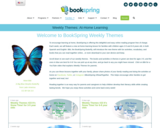
BookSpring, a 45 year old early literacy non-profit in Austin Texas, is providing rich digital content base on its time-tested educator kits online for families through 52 Weekly Themes for ages 3-5 and 6-8. Each week, a new theme related to early childhood curriculum is released with a video prompt to activate prior knowledge from Bibi the Butterfly, followed with a series of curated digital books in browser-based and downloadable pdf form. These resources are followed with reflection questions, suggested follow up activities, and additional resources to extend the learning at home. The materials are offered under a Creative Commons By-Share Alike license and available in both Spanish and English. The themes start in August 2020 and are planned to be completed in August 2021, and will be sustained online indefinitely. Plans for Toddler units (24-36 months) and older children (9-12) are being considered for future development. No log in is required, but donations are welcome and eligible as charitable contributions for the U.S. IRS. Aligned to multiple subjects in the Texas Essential Knowledge and Skills for grades K-3, as well as the Texas Prekindergarten Guidelines (not currently available on OER for alignment) https://tea.texas.gov/academics/early-childhood-education/texas-prekindergarten-guidelines

Gerhana Matahari 9 Maret 2016 di Indonesia dan Bagaimana Mengamati Gerhana dengan Aman

A 12-panel comic strip explaining what Boolean Operators are and how to use them.

This resource is a video abstract of a research paper created by Research Square on behalf of its authors. It provides a synopsis that's easy to understand, and can be used to introduce the topics it covers to students, researchers, and the general public. The video's transcript is also provided in full, with a portion provided below for preview:
"Neuroblastoma is a childhood tumor that forms in the neural crest during early development. While treatment has remained elusive, scientists do know that a partially deleted chromosome 11 contributes to one of the most aggressive forms of neuroblastoma. Here, researchers now say, lies an important gene whose absence gives rise to runaway tumor cell growth. That gene is discs large homolog 2, or DLG2. DLG2 and other genes in its family play important roles in cell structure and growth. DLG2 gene transfection experiments slowed the growth of neuroblastoma cells, whereas silencing DLG2 promoted neuroblastoma growth. A closer look revealed that low DLG2 expression fast-tracks cells through the growth phase of the cell cycle, bypassing a critical checkpoint designed to catch faulty DNA. A review of real-world patient data showed that low DLG2 expression is in fact correlated with poor survival in patients with neuroblastoma..."
The rest of the transcript, along with a link to the research itself, is available on the resource itself.

This resource is a video abstract of a research paper created by Research Square on behalf of its authors. It provides a synopsis that's easy to understand, and can be used to introduce the topics it covers to students, researchers, and the general public. The video's transcript is also provided in full, with a portion provided below for preview:
"SARS-CoV-2, the virus that causes COVID-19, continues to course through communities around the world. While researchers have learned enough about the virus to build defenses, much remains unknown about how SARS-CoV-2 interacts with the immune system to cause disease. One promising target researchers are exploring is a process known as “T cell exhaustion.” During infection, disease-fighting T cells are recruited to areas where inflammation is taking place. These cells are virus-specific and represent one of the most critical defenses against SARS-CoV-2. Some patients with COVID-19, however, show significantly reduced T cell counts, impairing their ability to fight the disease. Although it’s unclear how T cell exhaustion occurs, numerous potential biomarkers of this process do exist. Among these is the protein PD-1, which helps T cells identify cells as friend or foe..."
The rest of the transcript, along with a link to the research itself, is available on the resource itself.
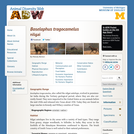
Boselaphus tragocamelus: Information
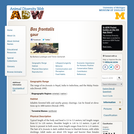
Bos frontalis: Information
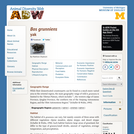
Bos grunniens: Information
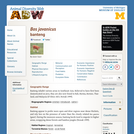
Bos javanicus: Information
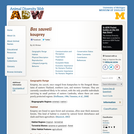
Bos sauveli: Information
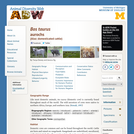
Bos taurus: Information
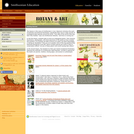
The lessons in this issue of Smithsonian in Your Classroom introduce the work of botanists and botanical illustrators, specifically their race to make records of endangered plant species around the world. “Very little of the world’s flora has been fully studied,” says one Smithsonian botanist, “and time is running out.” In the first lesson, students gets to know six endangered plants. They examine illustrations, photographs, and dried specimens of the plants as they consider this question: If a scientist can take a picture of a plant, are there advantages in having an illustration? They go on to consider some of the big questions that botanists themselves must ask: Which of these species are most in need of conservation efforts? Are any of these plants more worth saving than others?In the second lesson, the students try their own hands at botanical illustration, following the methods of a Smithsonian staff illustrator. All that is required for the lesson are pencils, markers, tracing paper, and access to a photocopier.
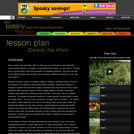
In The Botany of Desire, Michael Pollan explores risks inherent in one of the most widespread practices in modern agriculture. It's called monoculture, and it refers to cultivation of single or very similar varieties of a food crop on large acreages. In many cases, the variety is one that dominates the marketplace, like the Russet Burbank potato, whose shape makes it a favorite for cutting French fries, or one of the few apple varieties commonly seen in supermarkets. Monoculture may offer economic advantages, but Pollan argues that it brings serious environmental risks.
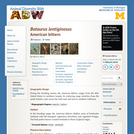
Botaurus lentiginosus: Information
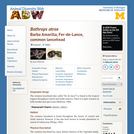
Bothrops atrox: Information

Diversidad vegetal y florística. Métodos de estudio de la diversidad vegetal.
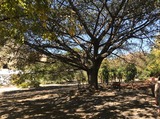
Los árboles son las plantas más complejas y resistenes del mundo. Conocer su importancia, composición, estructura y reconocerlos como entes indispensables en nuestros sistemas de vida, es imprescindible para diseñar respetuosamente, la arquitectura y el paisaje
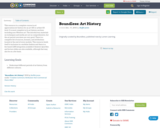
This resource is a complete course in art appreciation/art history for an art 100 or arthist 101 level. It is most complete in its art history sections including non-Western art. The introductory materials on techniques and media are not as comprehensive, but the art period overviews are very good. There is a complete list of sources, licenses, and attributions located at the end of every module. This resource lends itself to inclusion in a modular fashion and there is a fee-based LMS integration available if desired. Quiz files and lecture slides are also available, although that may also be on a fee-basis.

Online Biology textbook in epub format downloaded from Boundless before they went defunct. This was my first introduction to OER as a result of an online search to find alternatives to the high-cost biology textbooks I was using. I did not author this epub. I am merely uploading the epub that I downloaded years ago.